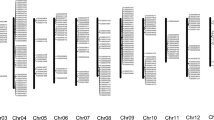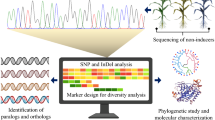Abstract
The transcription factors of the MYC gene family are an integral part of the MYB + MYC + WD40 regulatory complex required to activate the genes of plant flavonoid biosynthesis. The TaMyc1 gene, which controls the synthesis of flavonoid pigments in the grain pericarp, is known in bread wheat (Triticum aestivum L., BBAADD genome, 2n = 6x = 42). In the present work, we identified 10 copies of this gene in the T. aestivum genome, 22 copies in the nearest bread wheat relatives (T. durum, T. urartu, T. monococcum, Aegilops speltoides, Ae. sharonensis, Ae. tauschii). The analysis of genetic similarity of all these genes demonstrated that the MYC gene duplication occurred for the first time in the common diploid ancestor of the Triticeae tribe with the formation of copies in the second and fourth chromosomes. In the members of the Triticum and Aegilops genera, these genes underwent from two to four duplication acts that resulted in the formation of paralogous copies. The orthologs of the MYC genes obtained from ancestral diploid species exist in polyploid species of the Triticum genus (in addition to paralogues). The time of the emergence of individual MYC family members was calculated based on the average speed of accumulation of nucleotide substitutions (k) in the MYC genes (established in this work) and certain number of synonymous substitutions between individual copies.
Similar content being viewed by others
Abbreviations
- RT-PCR:
-
reverse transcription polymerase chain reaction
- bHLH:
-
basic helix-loop-helix
- MBW:
-
MYB + bHLH/MYC + WD40
- MYB:
-
myeloblastosis
- MYC:
-
myelocytomatosis
- WD40:
-
structural motif consisting of approximately 40 amino acids ending with W-D dipeptide (tryptophan–aspartic acid)
References
Walker A.R., Davison P.A., Bolognesi-Winfield A.C., et al. 1999. The TRANSPARENT TESTA GLABRA1 locus, which regulates trichome differentiation and anthocyanin biosynthesis in Arabidopsis, encodes a WD40 repeat protein. Plant Cell. 11, 1337–1349.
Baudry A., Heim M.A., Dubreucq B., et al. 2004. TT2, TT8, and TTG1 synergistically specify the expression of BANYULS and proanthocyanidin biosynthesis in Arabidopsis thaliana. Plant J. 39, 366–380.
Li S. 2014. Transcriptional control of flavonoid biosynthesis: Fine-tuning of the MYB-bHLH-WD40 (MBW) complex. Plant Signal. Behav. 9, e27522.
Winkel-Shirley B. 2002. Biosynthesis of flavonoids and effects of stress. Curr. Opin. Plant Biol. 5, 218–223.
Broun P. 2005. Transcriptional control of flavonoid biosynthesis: A complex network of conserved regulators involved in multiple aspects of differentiation in Arabidopsis. Curr. Opin. Plant Biol. 8, 272–279.
Vailleau F., Daniel X., Tronchet M., et al. 2002. A R2R3-MYB gene, AtMYB30, acts as a positive regulator of the hypersensitive cell death program in plants in response to pathogen attack. Proc. Natl. Acad. Sci. U. S. A. 99, 10179–10184.
Stracke R., Ishihara H., Huep G., et al. 2007. Differential regulation of closely related R2R3-MYB transcription factors controls flavonol accumulation in different parts of the Arabidopsis thaliana seedling. Plant J. 50, 660–677.
Lindemose S., O’Shea C., Jensen M.K., et al. 2013. Structure, function and networks of transcription factors involved in abiotic stress responses. Int. J. Mol. Sci. 14, 5842–5878.
Shoeva O.Y., Gordeeva E.I., Khlestkina E.K. 2014. The regulation of anthocyanin synthesis in the wheat pericarp. Molecules. 19, 20266–20279.
Gordeeva E.I., Shoeva O.Y., Khlestkina E.K. 2015. Marker-assisted development of bread wheat nearisogenic lines carrying various combinations of purple pericarp (Pp) alleles. Euphytica. 203, 469–476.
Khlestkina E.K., Shoeva O.Y., Gordeeva E.I. 2014. Flavonoid biosynthesis genes in wheat. Vavilov. Zh. Genet. Selekts. 18, 784–796.
The INRA URGI (Unité de recherche en Génomique-Info). 2000. URL: https://urgi.versailles.inra.fr/ Cited April 30, 2016.
Wilkinson P.A., Winfield M.O., Barker G.L., et al. 2012. CerealsDB 2.0: An integrated resource for plant breeders and scientists. BMC Bioinformatics. 13, 219.
NCBI R.C. 2016. Database resources of the National Center for Biotechnology Information. Nucleic Acids Res. 44 (D1), D7. URL: https://www.ncbi.nlm.nih.gov/ Cited April 30, 2016.
Solovyev V.V. 2007. Statistical approaches in eukaryotic gene prediction. In: Handbook of Statistical Genetics, 3rd ed. Eds. Balding D., Cannings C., Bishop M. Wiley-Interscience.
Corpet F. 1988. Multiple sequence alignment with hierarchical clustering. Nucleic Acids Res. 16, 10881–10890.
Tamura K., Stecher G., Peterson D., et al. 2013. MEGA6: Molecular Evolutionary Genetics Analysis version 6.0. Mol. Biol. Evol. 30, 2725–2729.
Sokal R.R. 1958. A statistical method for evaluating systematic relationships. Univ. Kans. Sci. Bull. 38, 1409–1438.
Nei M., Gojobori T. 1986. Simple methods for estimating the numbers of synonymous and nonsynonymous nucleotide substitutions. Mol. Biol. Evol. 3, 418–426.
Huang S., Sirikhachornkit A., Faris J.D., et al. 2002. Phylogenetic analysis of the acetyl-CoA carboxylase and 3-phosphoglycerate kinase loci in wheat and other grasses. Plant Mol. Biol. 48, 805–820.
Huang S., Sirikhachornkit A., Su X., et al. 2002. Genes encoding plastid acetyl-CoA carboxylase and 3-phosphoglycerate kinase of the Triticum/Aegilops complex and the evolutionary history of polyploid wheat. Proc. Natl. Acad. Sci. U. S. A. 99, 8133–8138.
Rychlik W. 2007. OLIGO 7 primer analysis software. In: Methods in Molecular Biology, vol. 402: PCR Primer Design. Ed. Yuryev A.V. Totowa, NJ: Humana Press Inc., pp 35–59.
Devos K.M., Dubcovsky J., Dvorak J., et al. 1995. Structural evolution of wheat chromosomes 4A, 5A, and 7B and its impact on recombination. Theor. Appl. Genet. 91, 282–288.
Cockram J., White J., Zuluaga D. L., et al. 2010. Genome-wide association mapping to candidate polymorphism resolution in the unsequenced barley genome. Proc. Natl. Acad. Sci. U. S. A. 107, 21611–21616.
Ludwig S.R., Habera L.F., Dellaporta S.L., et al. 1989. Lc, a member of the maize R gene family responsible for tissue-specific anthocyanin production, encodes a protein similar to transcriptional activators and contains the myc-homology region. Proc. Natl. Acad. Sci. U. S. A. 86, 7092–7096.
Hu J., Anderson B., Wessler S.R. 1996. Isolation and characterization of rice R genes: Evidence for distinct evolutionary paths in rice and maize. Genetics. 142, 1021–1031.
Wang C., Shu Q. 2007. Fine mapping and candidate gene analysis of purple pericarp gene Pb in rice (Oryza sativa L.). Chin. Sci. Bull. 52, 3097–3104.
Adzhieva V.F., Babak O.G., Shoeva O.Y., Kilchevsky A.V., Khlestkina E.K. 2015. Molecular-genetic mechanisms underlying fruit and seed coloration in plants. Vavilov. Zh. Genet. Selekts. 19, 561–573.
Himi E., Taketa S. 2015. Isolation of candidate genes for the barley Ant1 and wheat Rc genes controlling anthocyanin pigmentation in different vegetative tissues. Mol. Genet. Genomics. 290, 1287–129.
Shin D.H., Choi M.G., Kang C.S., et al. 2016. A wheat R2R3-MYB protein PURPLE PLANT1 (TaPL1) functions as a positive regulator of anthocyanin biosynthesis. Biochem. Biophys. Res. Commun. 469, 686–691.
Khlestkina E.K., Dobrovolskaya O.B., Leonova I.N., Salina E.A. 2013. Diversification of the duplicated F3h genes in Triticeae. J. Mol. Evol. 76, 261–266.
Author information
Authors and Affiliations
Corresponding author
Additional information
Original Russian Text © K.V. Strygina, E.K. Khlestkina, 2017, published in Molekulyarnaya Biologiya, 2017, Vol. 51, No. 5, pp. 772–779.
Rights and permissions
About this article
Cite this article
Strygina, K.V., Khlestkina, E.K. MYC gene family in cereals: Transformations during evolution of hexaploid bread wheat and its relatives. Mol Biol 51, 674–680 (2017). https://doi.org/10.1134/S0026893317050181
Received:
Accepted:
Published:
Issue Date:
DOI: https://doi.org/10.1134/S0026893317050181




